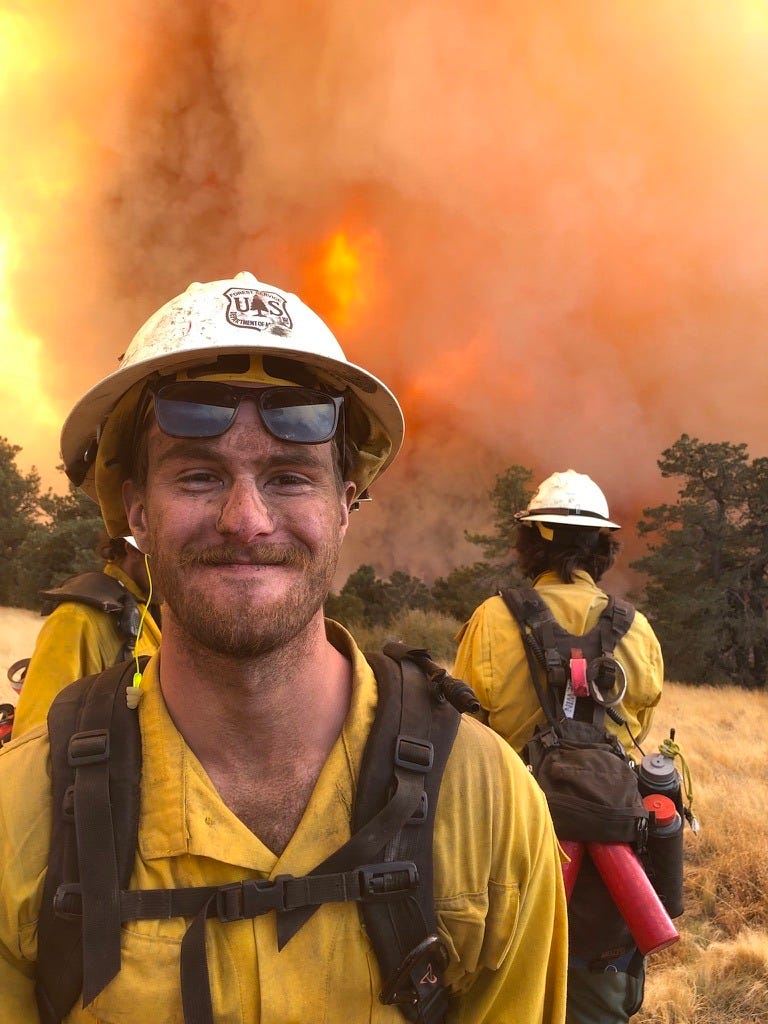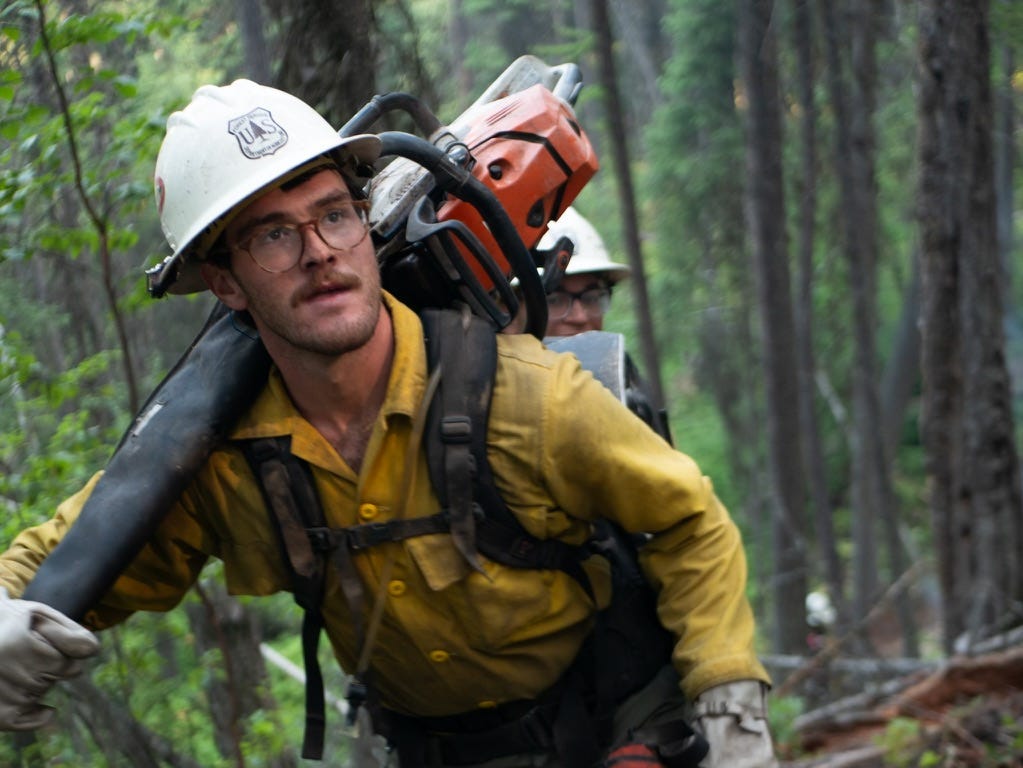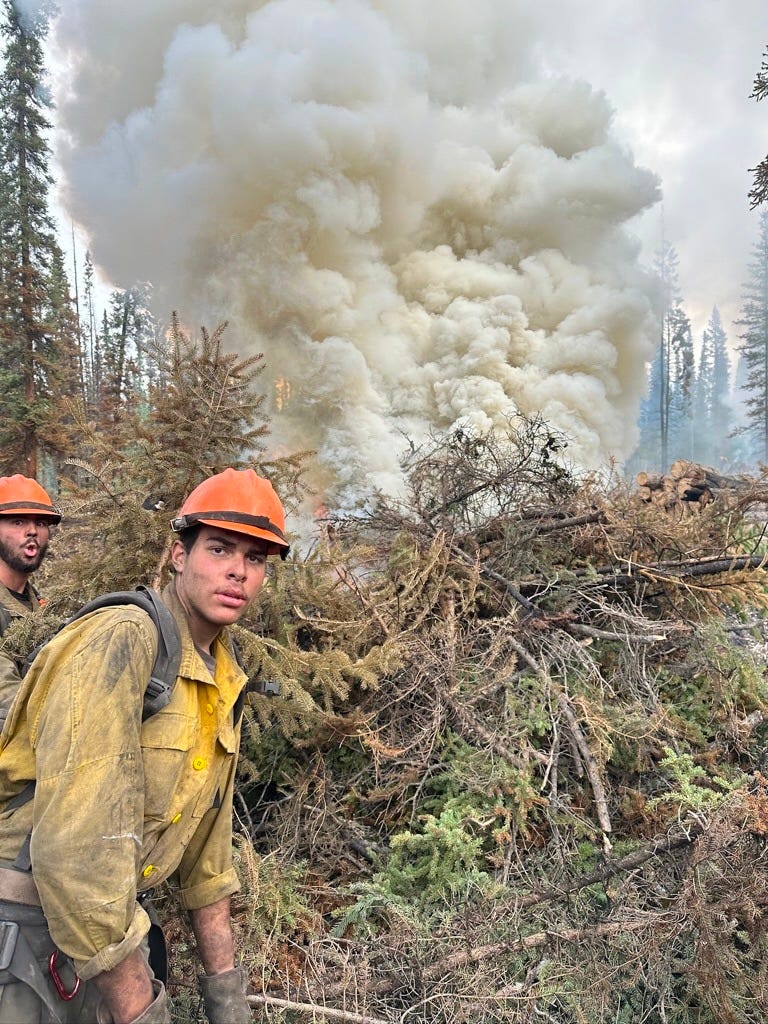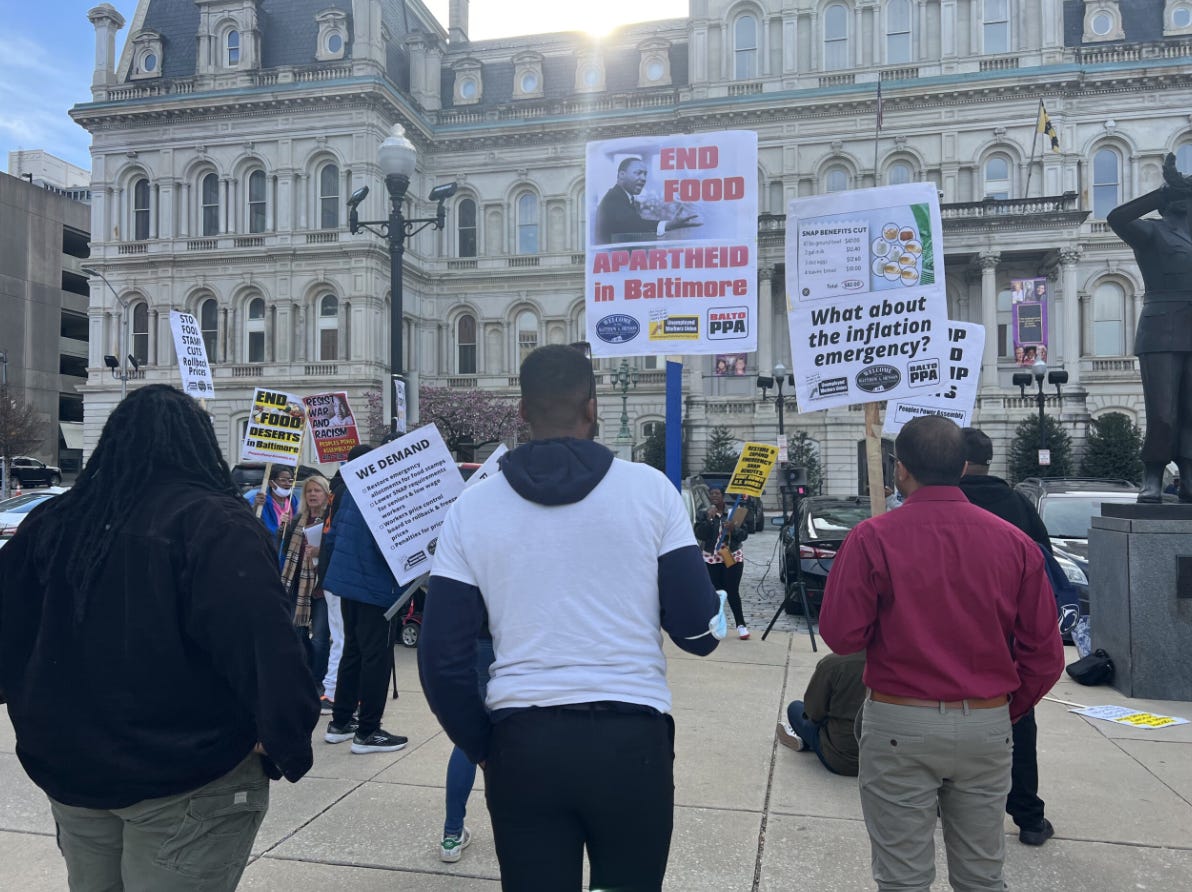Addressing Environmental Displacement
My brothers tackling US wildfires and my hope for a better future
For four years, I’ve watched my younger brother Ben tackle some of nature’s harshest fires as a hotshot wildland firefighter. These elite teams are the Navy SEALs of firefighting (though he eyerolls when I say that). They are highly trained, physically resilient, and deployed to the most dangerous wildfire zones. Meanwhile, our youngest brother, Marco, is now battling wildfires across the country as well, taking a similar path.
I couldn’t be prouder of my brothers’ dedication to protecting our nation’s forests and parks—ecosystems that provide clean air and absorb much of our carbon emissions. Yet, their work has me even more worried about the reality that wildfires are growing stronger and more destructive with each passing year.
Having lived in Los Angeles for seven years and visiting frequently, I’ve seen firsthand the devastation these fires leave behind. In January alone, wildfires caused billions in property damage and displaced over 10,000 people long-term. I sadly know multiple people who lost their homes and small businesses this time around. Entire neighborhoods were reduced to ash, while toxic chemicals and asbestos filled the air, exposing hundreds of thousands to hazardous conditions. For those displaced without financial resources to secure new housing, temporary aid often runs out quickly. Many are left with no choice but to move in with relatives, seek shelter assistance, or face homelessness.
As my brothers’ lives are on the line every day, it’s hard not to reflect on the larger picture.
Climate change is fueling longer fire seasons and more intense blazes. The forests my brothers work so hard to save are under dire threat—not just from flames but from a warming planet (not to mention defunding of fire safety and forest service support).
In graduate school, I am pursuing a Certification in Humanitarian Crises, Refugees and Migration and a Specialization in Agriculture and Food Systems. I am deeply fascinated by climate migration and what it means for us all. The following is an adaptation I wrote for a course only months before the January fires in LA.
While conflicts over power, identity, and religion are often seen as the primary drivers of refugee crises and internal displacement, another potent force is quietly reshaping migration patterns: resource scarcity and environmental disasters. From droughts and wildfires to flooding and soil erosion, these climate-induced events are displacing millions of people around the world and igniting conflicts over communal land and water access. The ripple effects of these crises extend far beyond the immediate regions affected.
Droughts don’t just dry up rivers; they cripple agricultural yields, destabilizing food systems and driving up prices, sometimes leading to export bans, panic buying, and even social unrest. In 2022 alone, over 12,500 protests erupted globally over food and fuel prices—a stark reminder of how deeply intertwined food and basic resource security are with political stability. (See another blog of mine detailing more on food instability.)
As we saw in LA, prolonged dry periods can lead to entire communities burning down. These dry periods can also decimate the food supply and the livelihoods of 1.23 billion people directly employed in the world’s agrifood system, including the smallholder farmers at the foundation of the supply chain. Expanding this further, ~3.5 billion people live in households linked to the agrifood system (i.e., farming, food processing and distribution, supply chains, and transportation). Half of our population is dependent on the agri-food system for their livelihood.
For the most vulnerable, drought and drastic climate shifts leave farmers with few options to sustain their livelihoods. Many are forced to flee, contributing to rising migration rates, while others remain and compete for dwindling resources like water and arable land. This often leads to violent conflicts. These tensions can overwhelm already strained governments and, in some cases, create fertile ground for terrorist recruitment.
A striking example comes from areas under ISIS control, where climate-induced resource scarcity played a critical role. Severe hunger plagued many young Iraqis as agricultural systems collapsed under drought conditions. ISIS exploited this desperation by monopolizing trade and employment opportunities, leaving residents with few alternatives but to rely on the organization for survival. When crops fail, food becomes scarce, and families go hungry, people will do whatever it takes to feed their loved ones—even if it means joining extremist groups.
In the context of the Western United States, the prolonged drought conditions have led to agricultural losses, which have broader impacts on the local and national economies. 12% of land in western states is classified as experiencing extreme or exceptional drought, with an additional 20% classified as severe. California is the largest agricultural producer in the United States, accounting for almost 11% of the country's total agricultural output. California also has water-intensive agriculture (e.g., almonds), exacerbating the already vulnerable conditions that are leading to high rates of wildfires due to drought and water scarcity.
In 2023, California’s extreme temperature swings delayed planting and destroyed crops, including 20% of the state’s strawberry crop, which usually brings in ~$3 billion a year for the state and directly employs about 70,000 people through the strawberry supply chain. The threat doesn’t end with lost harvests. State officials are increasingly alarmed by the rapid decline of the Sierra Nevada snowpack, California’s most vital natural water reservoir. Historically, the snowpack gradually releases about 15 million acre-feet of water each year, sustaining cities, farms, and ecosystems. Now, climate change is accelerating snowmelt, overwhelming water storage systems, and heightening the risk of both floods and water shortages. Earlier this year, the Trump administration’s decision to release water reserves failed to address the wildfire crisis and left many farmers facing even greater uncertainty going into this summer’s hot, dry season.
Wildfires, fueled by persistent drought, are compounding these challenges. Between 2017 and 2022, wildfires destroyed the homes of 31,000 families in California. In September 2024 alone, more than 115,000 people were placed under evacuation orders as three major fires raged across the state.
** It is projected that 1 in 12 Americans living in the southern half of the country may be forced to relocate over the next 45 years due to climate pressures (controlling for other factors).**
Change is coming fast. As climate pressures reshape where people live and drive up demand for food, the stakes for sustainable solutions have never been higher. Global food production will need to increase by 70% by 2050 to feed a growing population, even as the land and water needed for that growth face mounting threats from extreme weather and resource scarcity.
California’s agricultural prowess is rooted in earlier waves of adaptation. After the Gold Rush of 1849, many settlers turned to farming, and the completion of the Transcontinental Railroad in 1869 linked California’s produce to distant markets. These investments fueled an agricultural boom, spurring ongoing research and innovation. California’s response to the climate crisis will reverberate far beyond its borders. As the world’s fifth-largest economy and the source of nearly half the nation’s fruits, nuts, and vegetables, the state’s choices about how to manage its agricultural future will shape food systems and climate resilience across the country. Meeting this moment requires more than incremental change. It calls for forward-thinking strategies and unprecedented collaboration among policymakers, researchers, and growers to confront the crisis at our doorstep.
California’s agriculture sector is leading the way in adopting climate-smart technologies to meet growing environmental challenges. Farmers increasingly rely on precision agriculture tools such as GPS-guided tractors, drones for crop monitoring, and IoT sensors that track soil moisture and nutrient levels. Water conservation methods like drip irrigation and drought-resistant crop varieties are also becoming standard as water scarcity intensifies. Nationwide, about half of large-scale farms have integrated some form of precision agriculture to boost yields and resource efficiency. One strawberry grower reported cutting water use by 27% thanks to precision irrigation systems combining drip irrigation with soil tension monitoring.
However, the high upfront costs of these technologies have limited adoption among smaller farms, creating a technological divide within the agricultural community. To bridge this gap, the state has introduced subsidy programs and educational initiatives through organizations like the University of California Cooperative Extension. Public universities have also expanded academic programs in precision agriculture to prepare the next generation of farmers and researchers.
Environmental displacement is not just a California story, it’s a global reality playing out in places like Kenya, Somalia, and countless other regions where drought and climate pressures are pushing people from their homes and undermining food security. California’s experience with prolonged dry spells and wildfires is an important reminder that environmental disruption can upend livelihoods and displace entire communities anywhere.
Solutions must go beyond emergency response and focus on building resilience at every level. Climate-smart agriculture is one proven path: by integrating precision technologies, drought-resistant crops, and efficient irrigation, farmers can adapt to changing conditions while protecting yields and natural resources. Globally, projects led by organizations like the FAO and World Bank have shown that tailoring climate-smart practices to local needs through participatory planning, targeted training, and farmer-led innovation can boost productivity, strengthen food systems, and reduce emissions.
Emerging technologies are also reshaping what’s possible. Artificial intelligence and data analytics now guide planting cycles, optimize water and fertilizer use, and even help breed crops that can withstand heatwaves and pests. Regenerative agriculture, focused on restoring soil health and biodiversity, offers a long-term solution to reversing land degradation and sequestering carbon. Meanwhile, new initiatives are helping farmers transition away from harmful chemicals, with financial incentives and technical support to encourage safer, more sustainable practices.
Ultimately, building resilience to environmental displacement means investing in innovation, sharing knowledge across borders, and supporting policies that put farmers and vulnerable communities at the center of climate adaptation. California’s response will influence the nation and the lessons learned here can help us chart a more sustainable path for everyone around the world.






